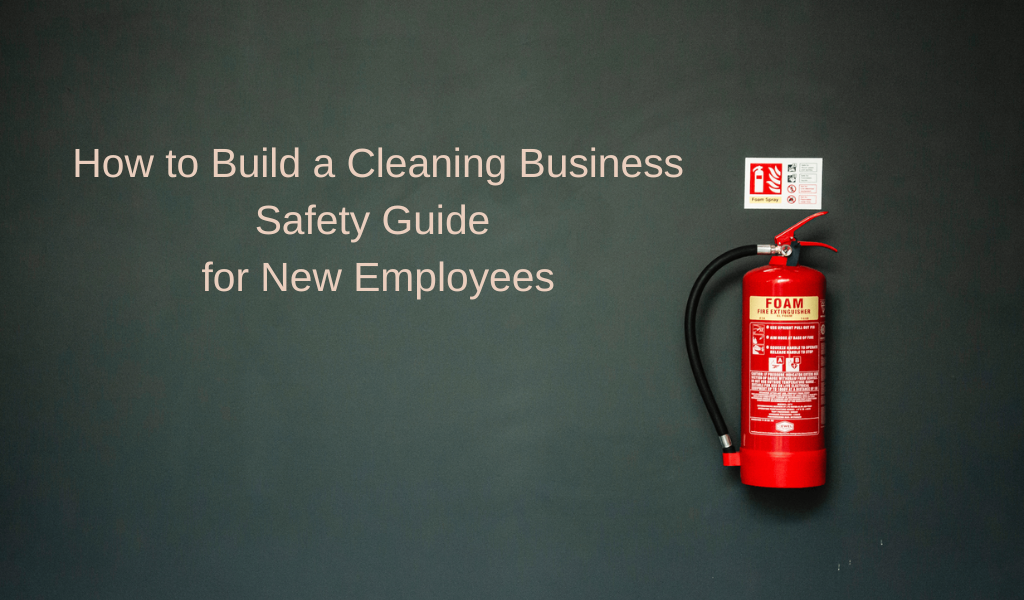Find out how to build a cleaning business safety guide so your new (and veteran) employees can stay safe at work.
When you want to ensure your team works safely, it’s helpful to have a set of procedures and protocols that plot out how to work safely, what to do in the case of an emergency, and what the expectations are for the team. But determining how to build a cleaning business safety guide can also feel overwhelming.
There’s no possible way you can include every potential situation in a guide. But where can you begin? What does get included? What gets left out?
Here are some tips on how to build a cleaning business safety guide from scratch, so you know your team knows what to do in the event of an emergency.
Ready to strengthen employee and customer relationships? Let’s start the conversation! Reach out today for more info.
Find out how to build a cleaning business safety guide for your entire team (and especially the new people on your team)
First, your guide doesn’t have to be perfect. So let’s get that assumption out of the way. You may add to it or alter it over time to improve what you have. Your primary goal, for now, is to figure out how to build a cleaning business safety guide that covers the most common issues you encounter. You also want to put together a guide that helps your team think about safety not as a checklist item, but as a business priority.
Of course, one of your best sources of information is the Occupational Safety and Health Administration (OSHA). On their website, you’ll find specific information regarding common general industry standards, such as information that applies to flammable liquids, eye protection, and ventilation.
You’ll also find a section on the OSHA website related to cleaning chemicals and ventilation in confined spaces. Both of those offer excellent starting points for your safety guide. However, you want something more specific to your business. So let’s look at how to build a cleaning business safety guide geared specifically to what you do.
1. State your commitment to safety. You can get as in-depth here as you want, but there are a few points to make. Along with stating your commitment to safety, be specific about whom employees can report safety concerns to. And ensure them that there will be no retaliation. If your team feels uncomfortable reporting safety issues, your entire safety program is at risk.
2. Start with the basics. It’s never a bad idea to remind people of some basic safety procedures. In the case of janitorial work, that includes things like wearing non-slip shoes, setting out “wet floor” signs, and proper lifting techniques.
3. Review common safety concerns. Remind your team that injuries may result from slip-and-fall accidents, poor ergonomics, repetitive motions, chemicals, and electrical hazards. Offer examples of how to avoid these injuries, such as keeping heavier boxes on lower shelves, wearing proper PPE when using chemicals, or avoiding potential electrical hazards.
4. Discuss chemical safety. Cleaning chemicals, even green cleaning products, may be especially hazardous. These products may irritate the skin, eyes, and airways, in which case employees should wear appropriate PPE. Furthermore, remind your employees to NEVER mix cleaning products. Some combinations, such as bleach- and ammonia-based products, can form dangerous gasses.
5. Review safety symbols and SDS sheets. Safety data sheets, more commonly referred to as SDS sheets, provide extensive information about different chemicals, including flammability, corrosiveness, and other hazards. Review safety symbols, as well. Chemical symbols are good to know, but include any color-coded cleaning systems you may have in place, too.
6. Cleaning product spill protocol. As you’re thinking about how to build a cleaning business safety guide, don’t forget about what to do in the event of spills and emergencies. It’s essential to have guidelines around this, including what to do with different hazards (i.e., evacuating the area or building), what to use to clean up spills, and how to report these spills.
7. Safe work practices. Review safe work practices, such as how to safely store equipment, how to dilute cleaning products, proper handling of cleaning products, and proper ergonomics.
8. What to do in the event of an emergency. Despite your best efforts, your team may run into an emergency situation at some point. Review what to do in different situations, whether that’s rendering first aid, calling emergency services, or notifying a supervisor.
While much of the success of your safety guide will depend on how well your team implements the suggestions and protocols, remember that safety is your responsibility. Ensure your team gets the information in a language they can understand. As well, offer hands-on training where appropriate.
Safety may take a little time and energy up front, but the return on your investment is beyond accounting.
Make your cleaning business more organized, efficient, and profitable. Schedule a free call with Janitorial Manager to learn how mobile-friendly scheduling software can help you streamline your operation like never before.


